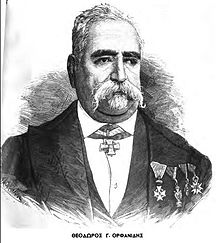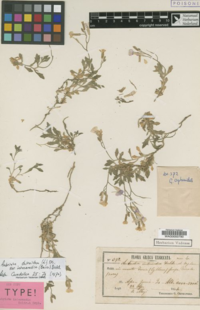| Theodoros Orphanides | |
|---|---|
 | |
| Born | 1817 Koukouli, Ioannina, Ottoman Empire |
| Died | 5 August 1886(1886-08-05) (aged 68–69) Athens, Greece |
| Nationality | Greek |
| Alma mater | University of Paris National Museum of Natural History, France |
| Known for | Botanical Classification |
| Scientific career | |
| Fields | Botany Plant Taxonomy Scientific classification |
| Institutions | University of Athens |
| Doctoral advisors | Adolphe-Théodore Brongniart |
| Author abbrev. (botany) | Orph |
Theodoros Orphanides or Orphanidis (Greek: Θεόδωρος Ορφανίδης; 1817 – 5 August 1886) was a poet, professor, politician, author, and botanist. He was a pioneer in 19th-century Greek botany. He helped organize the botanical garden in Greece. The genus Orphanidesia is named after him. He collected 3483 specimens from 21 countries and identified 413 specimens from 9 different countries. He was a Professor of Botany at the National and Kapodistrian University of Athens. He was one of the leading representatives of the First Athenian School. He received the Ralio award three times.
Early life
He was born in Izmir but his parents were from Chios, Greece. He was from a prominent wealthy family. His older brother was Dimitris Orphanides. He was a world-renowned doctor. His nephew was Greek Olympian Georgios Orphanidis. After the outburst of the Greek Revolution, his family was forced to move to Nafplio and later Tinos. They finally settled on the island of Syros. He finished high school on the island of Syros. In 1835, at the age of 18, he moved to Athens. He was appointed ministerial scribe for the Ministry of Interior. While he lived in Athens he began to show an interest in writing political satire. Regrettably, because he was constantly criticizing the King of Greece in his political satire he was fired from the ministry and was sentenced to 3 days in jail. He published two poems with the title Menippus from 1836-1837. Four years later he was writing for the satirical newspaper (Archer) Τοξότης. In 1842, he wrote a poem entitled The First Martyr Rigas and the Greek Revolution (Ο Πρωτομάρτυς Ρήγας και η Ελληνική Επανάστασις). In 1844, at the age of 27 after the personal intervention of the Greek Prime Minister Ioannis Kolettis. Theodore was sent to France on a scholarship from the Greek government. He studied at the prestigious botanical garden of the National Museum of Natural History it was converted into a special academic research facility after the French Revolution. The institution was part of the University of Paris and Sorbonne University system. The facility had one of largest botanical gardens in the world at the time. It housed the Royal Garden of Medicinal Plants created by King Louis XIII in 1635. Theodoro's professors at the institution were Adrien-Henri de Jussieu, Adolphe-Théodore Brongniart, Joseph Decaisne and Achille Richard.
Academic career

When he returned to Athens on August 11, 1850, he was appointed Professor of Botany at the National and Kapodistrian University of Athens. Four years later in 1854, he was awarded full Professor status. He maintained his position for over thirty years. The university was very political in nature. College professors usually participated in political debates and issues. Dimitrios Stroumpos and Ioannis Papadakis were some of the other professors dragged into Greece's political issues. The university faculty and government created an alliance that led to the departure of world-renowned astronomer Georgios Konstantinos Vouris. Vouris was Greek-Austrian. He was from the same country as the King of Greece. During the years 1867 – 1868 Orphanides was Rector of the University. He was tirelessly collecting floral species from all over Greece. Theodore pressed the plants using a plant press and prepared them for classification. Specimens were prepared and glued to archival-quality card stock with their labels. Labels were made with special ink and attached with archival-quality glue. Theodore prepared countless plant specimens. The dried plants were added to his herbarium some were sent to different botanists all over the world. His plant material formed a remarkable Herbarium with over 45,000 specimens. He traveled across Greece studying plant diversity. He published his findings in an exsiccata work entitled Flora Graeca Exsiccata. Theodore was also the superintendent of the botanical garden and the state arboretum, he introduced ornamental plants and he was actively involved in the design and creation of urban public parks. He oversaw the creation of the National Garden of Athens. Theodore frequently collaborated with world-renowned botanists some included Theodor von Heldreich and Pierre Edmond Boissier. When he died his Herbarium was purchased by national benefactor Theodoros Rodokanakis. Rodokanakis donated the collection to the Botanical Museum of the University.
Rectors Speech
When Theodore became rector of the University of Athens he gave a notable speech on November 26, 1867. He discussed Greek vegetation and the classification and nomenclature of Greek flora. The speech was over 75 pages. Thirty pages of the speech were taxonomic tables where the classes, orders, and species of the Greek flora were described. Forty-five pages included the scientific clarification of botany. He was concerned with enriching the school's museum with botanical species. He was also concerned that students showed little interest in the natural sciences. He also discussed the need for a Greek botanical journal to communicate with Europe. He eventually started his own journal several years after his speech in 1872 entitled Γεωπονικά Geoponika. He noted that most of his work from touring the Greek countryside was used by world-renowned Swiss botanist Pierre Edmond Boissier in his publication. The publication gave prestige and recognition to Theodore's work. Theodore explained that Theophrastus was the father of botany but he also made reference to the modern advancements of Georges Cuvier and Carl Linnaeus. He wanted Greece to follow the European path of botanical studies. He also wanted to modernize his department.
Literary works
| Date | Title | Title in English |
|---|---|---|
| 1836 | Ο Μένιππος·Ποιήσεις Α | The Poems Menippus A |
| 1837 | Ο Μένιππος· Ποιήσεις Β | The Poems Menippus B |
| 1841 | Ο Τοξότης ( Έμμετρη Σατιρική Εφημερίδα) | The Archer (Published in the Emmetrical Satirical Newspaper) |
| 1842 | Ο Πρωτομάρτυς Ρήγας και η Ελληνική Επανάστασις | The First Martyr Rigas and the Greek Revolution |
| 1850 | Ankuendigung Flora Graeca Exsiccata | Identification of Dried Greek Flora |
| 1854 | Ο Άπατρις (αποσπάσματα) | Apatris (excerpts) |
| 1855 | Η Πόλις των Αθηνών | The City of Athens |
| 1858 | Τίρι Λίρι Ή Το Κυνηγέσιον Εν τη Νήσω Σύρω, Ποίημα Ηρωικοκωμικόν Εις Μέρη Επτά | Tiri Leery Or The Hunt In The Isles Of Syros, A Heroic-Comedian Poem In Seven Parts |
| 1858 | Χίος Δούλη Ποίημα Επικόν εις Άσματα Πέντε | Slave of Chios Epic Poem in Five Parts |
| 1858 | Άννα και Φλώρος Ή Ο Πύργος της Πέτρας | Anna and Floros Or The Tower of Stone |
| 1858 | Ο Ιώτας | Iotas |
| 1859 | Ποιήσεις Α | Poems A |
| 1860 | Άγιος Μηνάς (επεισόδιον της ελλην.επαναστάσεως) and Ποίημα λυρικο – επικόν υπό Θεοδώρου Ξένου | Agios Minas (Episode of the Greek Revolution) and Epic Lyrical poem by Theodoros Xenos |
| 1877 | Catalogus Systematicus Herbarii Theodori G. Orphanidis Professoris Botanices Nunc Munificentia Clarissimi Theodori P. Rhodocanakis in Museo Botanico Universitatis Athenarum | The Systematic Catalog of the Herbarium of Theodore G. Orphanidis, Professor of Botany Now the Munificence of the Most Famous Theodorus P. Rhodocanakis in the Botanical Museum of the University of Athens |
| 1916 | Τα Άπαντα · Μετά βιογραφικού Προλόγου υπό Ιω. Ζερβού | Ta Apata After a biographical Prologue by Io. Zervos |
Eponymy
The plant species Heracleum orphanidis, Centaurea orphanidea, Biebersteinia orphanidis, Campanula orphanidea, Euphorbia orphanidis, Nepeta orphanidea, Tulipa orphanidea, Verbascum orphanideum and Viola orphanidis are named after him.
The standard author abbreviation Orph. is used to indicate this person as the author when citing a botanical name.See also
- Heinrich Moritz Willkomm
- Galanthus reginae-olgae
- Aristotle's biology
- Karl Nikolas Fraas
- Theodor von Heldreich
References
- Staff Writers (2008). "Theodoros G. Orphanides". Biology Department National and Kapodistrian University of Athens. Retrieved September 10, 2022.
- Staff Writers (September 10, 2022). "Theodoros Georgios Orphanides". Bionomia. Retrieved September 10, 2022.
- Staff Writers (September 10, 2022). "Theodoros Georgios Orphanides". CETAF BOTANY PILOT. Retrieved September 10, 2022.
- Staff Writers (September 11, 2022). "Orfanidis Theodoros". Greek National Documentation Center. Retrieved September 11, 2022.
- Staff Writers (September 11, 2022). "Archive PRI110.01 - Theodoros G. Orphanides (Κ106)". Greek National Search Engine. Retrieved September 11, 2022.
- Staff Writers (September 11, 2022). "The History of the Museum". Musèum Nal Hist Naturele. Retrieved September 11, 2022.
- De Bort, Teissereng (1880). Congrès international de botanique et d'horticulture, tenu à Paris du 16 au 24 Aout 1878 [International Congress of Botany and Horticulture, held in Paris from August 16 to 24, 1878]. Paris, FR: Government of France. p. 52.
- Sakellaropoulos 1898, pp. 461.
- Orphanides, Théodore G (1850-01-01). Prospectus Flora Graeca exsiccata. Collection de plantes rares et interessantes de la Grèce (in French). Athènes: impr. C. Nicolaides. OCLC 492444304.
- "Flora Graeca Exsiccata: IndExs ExsiccataID=833980544". IndExs – Index of Exsiccatae. Botanische Staatssammlung München. Retrieved 29 August 2024.
- Stefanidou 1952, pp. 10–11.
- Savaidou 2010, pp. 59–66.
- International Plant Names Index. Orph.
Bibliography
- Savaidou, Irini Mergoupi (2010). 'Δημόσιος Λόγος περί Επιστήμης στην Ελλάδα, 1870–1900: Εκλαϊκευτικά Εγχειρήματα στο Πανεπιστήμιο Αθηνών, στους Πολιτιστικούς Συλλόγους και στα Περιοδικά [Public Discourse about Science in Greece, 1870-1900: Population Projects at the University of Athens, in Cultural Associations and Magazines] (PDF). Athens, GR: Department of History and Philosophy of Science of the University of Athens.
- Tampakis, Costas (2013). Sciences and religion: Their interaction in the borders of Europe (1832-1915) (PDF). Athens, GR: Colloque International, Europe et Sciences Modernes, Histoire d’un Engendrement Mutuel, Nantes, 21-22/2/2013.
- Johnson, A. T.; Smith, H.A; Stockdale, A. (2019). Plant Names Simplified: Their Pronunciation, Derivation and Meaning (3rd ed.). Sheffield, UK: 5m Publishing. ISBN 9781912178810.
- Harland, Gail (2016). Snowdrop. London, UK: Reaktion Books. ISBN 9781780236285.
- Sakellaropoulos, Meletios ( (1898). Εκκλησιαστικόν δίκαιον των Ανατολίκων Ορθοδόξου Εκκλησιάς [Ecclesiastical Archives of the Eastern Orthodox Church]. Athens, Gr: Saliveroy Press.
- Stefanidou, Micheal K. (1952). Εθνικόν και Καποδιστριακόν Πανεπιστήμιον Αθηνών Εκατονταετηρίς 1837-1937 Ιστορία της Φυσικομαθηματικής Σχολής [National and Kapodistrian University of Athens Centenary 1837-1937 History of the Faculty of Physics and Mathematics] (PDF). Athens, Greece: National and Kapodistrian University of Athens.